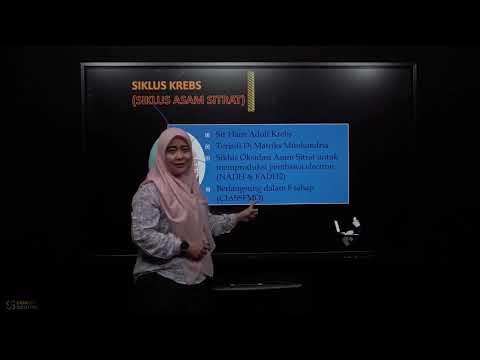Bagaimanakah tahapan Dekarboksilasi Piruvat (DO) atau Oksidasi Piruvat?
Summary
TLDRThis video discusses oxidative decarboxylation, a crucial step connecting glycolysis and the Krebs cycle. It highlights the process occurring in eukaryotic cells, particularly within mitochondria, where energy production predominantly takes place. The video explains how pyruvate, generated from glycolysis, loses a carbon to form acetyl-CoA, releasing carbon dioxide. It emphasizes the importance of capturing high-energy electrons through NADP, ultimately leading to ATP formation. Additionally, it outlines the necessity of coenzyme A for acetyl's transport into mitochondria. The video concludes by noting the outputs of the decarboxylation process: two NADH, two carbon dioxide, and two acetyl-CoA molecules.
Takeaways
- 😀 Oxidative decarboxylation is an important step linking glycolysis and the Krebs cycle.
- 🏢 This process occurs in the mitochondria, which have a double membrane structure.
- 🔄 Glycolysis takes place in the cytosol, and the products must enter the mitochondrial matrix.
- 🔬 Pyruvate, a three-carbon molecule from glycolysis, loses one carbon to form acetyl.
- 💨 The lost carbon is released as carbon dioxide (CO2) during oxidative decarboxylation.
- ⚡ High-energy electrons are released when carbon bonds are broken, essential for ATP production.
- 🔋 NADP captures these high-energy electrons, forming NADH, which contributes to ATP synthesis.
- 🛑 Acetyl cannot directly enter the mitochondria; it requires a carrier known as coenzyme A (CoA).
- 🔗 Acetyl-CoA is formed when acetyl binds with CoA, allowing it to enter the mitochondrial matrix.
- 🔄 The products of oxidative decarboxylation include 2 NADH, 2 CO2, and 2 acetyl-CoA from two pyruvate molecules.
Q & A
What is oxidative decarboxylation, and why is it important?
-Oxidative decarboxylation is a crucial process that links glycolysis to the Krebs cycle. It facilitates the conversion of pyruvate, produced during glycolysis, into acetyl-CoA, which is necessary for entering the Krebs cycle.
Where does oxidative decarboxylation occur in eukaryotic cells?
-This process occurs in the mitochondria of eukaryotic cells, which are double-membraned organelles known for energy production.
What happens to pyruvate during oxidative decarboxylation?
-Pyruvate, which has three carbon atoms, loses one carbon atom during oxidative decarboxylation, forming carbon dioxide and producing a two-carbon compound called acetyl.
What is the significance of the carbon dioxide produced in this process?
-The carbon dioxide produced is a byproduct that leaves the cell, while the removal of a carbon atom also leads to the release of high-energy electrons.
How are high-energy electrons captured during oxidative decarboxylation?
-The high-energy electrons released during the breaking of carbon bonds are captured by NAD+, forming NADH, which is then used to produce ATP in the electron transport chain.
What role does coenzyme A (CoA) play in oxidative decarboxylation?
-Coenzyme A acts as a carrier molecule that binds to acetyl to form acetyl-CoA, allowing it to enter the mitochondria and participate in the Krebs cycle.
What are the final products of oxidative decarboxylation per molecule of glucose?
-For each glucose molecule, the oxidative decarboxylation process produces two molecules of NADH, two molecules of carbon dioxide, and two molecules of acetyl-CoA.
Why can't acetyl enter the mitochondria directly?
-Acetyl cannot enter the mitochondria directly due to the semi-permeable nature of the mitochondrial membrane, which restricts the entry of certain molecules.
How does the process of oxidative decarboxylation link glycolysis and the Krebs cycle?
-Oxidative decarboxylation converts pyruvate from glycolysis into acetyl-CoA, which is essential for initiating the Krebs cycle within the mitochondria.
What benefits do students receive from the educational program mentioned at the end of the video?
-Students can receive a 50% discount on learning programs by using a specific code after watching the video, as part of a collaboration between 'Eksakta Educator' and 'Sekolahmu'.
Outlines

Cette section est réservée aux utilisateurs payants. Améliorez votre compte pour accéder à cette section.
Améliorer maintenantMindmap

Cette section est réservée aux utilisateurs payants. Améliorez votre compte pour accéder à cette section.
Améliorer maintenantKeywords

Cette section est réservée aux utilisateurs payants. Améliorez votre compte pour accéder à cette section.
Améliorer maintenantHighlights

Cette section est réservée aux utilisateurs payants. Améliorez votre compte pour accéder à cette section.
Améliorer maintenantTranscripts

Cette section est réservée aux utilisateurs payants. Améliorez votre compte pour accéder à cette section.
Améliorer maintenant5.0 / 5 (0 votes)






